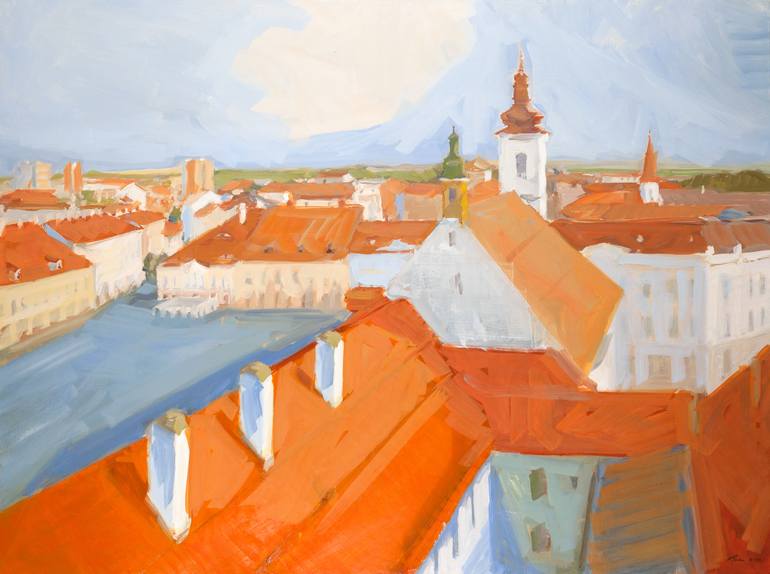







VIEW IN MY ROOM
Sibiu, Piata Mare Painting
Romania
Painting, Oil on Canvas
Size: 31.4 W x 23.6 H x 1.2 D in
Ships in a Box
Shipping included
14-day satisfaction guarantee
Artist Recognition

Artist featured in a collection
About The Artwork
This is an urban landscape with Piata Mare in Sibiu, Romania. An oil on canvas painting made in 2014. Literature: Emil Nicolae, "Dumitru D. Bostan-The place and the Journey", Piatra-Neamt, 2014, p. 89, illustrated. An art book with 105 illustrations of the original artworks. Exhibited: “Nemteni la Bruckenthal”, group exhibition, 30 artworks, Bruckenthal Museum, Sibiu, 2014. Testimony of a lyrical sensitiveness, but lacking a clear individuality, in as far as thematic, manner and style, and even atmosphere are concerned, the creation of Dumitru Bostan seems to follow in the tradition of the inter-war Romanian watercolour. The figurative is the constant of his paintings, too, and his landscapes (especially his cityscapes) give the true measure of his creation. There is something of Tonitza in his works (that diffuse melancholly) or of the cityscapes of Petraşcu or Vasile Popescu (unexpected cutting of motifs, the free, and surprisingly harmonious use of colours, with a bias for the fauve chromatic), of Ştefan Dimitrescu (with his sad light) or of Francisc Şirato (allusive transparencies and crecious colours), that oozes from the creations of Dumitru Bostan, whereas, in his more recent creations there is a touch of melancholly coming from Utrillo’s representations of Montmartre. Clearly arranged compositions, where the shapes are well defined by the intervention of the line on which the colour is spread in a well ballanced manner, with an obvious bias for blue, but with frequent interventions of the hot colours of a summer day. Thus, his landscapes, in which we recognize the motifs he loved most, (the streets and the yards of Piatra Neamt, the Verdun Boulevard from Biarritz, the houses, bridges and the squares of Venice, the Isle of Murano and then the narrow streets of Sibiu or the Liars’ Bridge in Sibiu), breathe a melancholly meditation enhanced by a the lack of human presence. The suggestions are delicate, insinuating, coming from the artist’s discreet confessions, who prefers to filter his emotions through watercolour, a technique of light and transparencies where strong contrasts don’t fit in. In the painting The Liars’ Bridge, donated to the museum by the artist, we recognize his bias for concise compositions, ballanced and with a modest paraphernalia, with carefully and subtly harmonized chromatic, the element which identyfies the artist and which converts the message from a cerebral message into an emotional one. Iulia Mesea Brukenthal. Acta Musei, IX. 2, 2014
Details & Dimensions
Painting:Oil on Canvas
Original:One-of-a-kind Artwork
Size:31.4 W x 23.6 H x 1.2 D in
Frame:White
Ready to Hang:Yes
Packaging:Ships in a Box
Shipping & Returns
Delivery Time:Typically 5-7 business days for domestic shipments, 10-14 business days for international shipments.
Handling:Ships in a box. Artists are responsible for packaging and adhering to Saatchi Art’s packaging guidelines.
Ships From:Romania.
Customs:Shipments from Romania may experience delays due to country's regulations for exporting valuable artworks.
Have additional questions?
Please visit our help section or contact us.
Dumitru D. Bostan was born on the 27th of November 1962 in Piatra-Neamt, Romania. Graduate the Institute of Fine Arts in Bucharest in 1986, specialized in monumental art and mural painting restoration. Member of The Romanian Union of Artists. Individual and collective exhibitions: Personal exhibitions, “Lascar Vorel” Gallery, Piatra-Neamt, Romania, 1995-2011. The National Graphic Show, Bucharest, Romania, 1996. The Art Biennial Exhibition, Piatra-Neamt, Romania,1997-2011. Kunstschow Westerschowen, “Galerie Geluk”, Burgh Haamstede-Holland, 1998. Group exhibitions at the “Apollo and “Artis” Gallery, National Theatre, Bucharest, 2004, 2006, 2007. Personal exhibition at the United Nations Center, Bucharest, 2005. The National Art Show, Bucharest, Romania, 2006. Group exhibition, “Confluences” at the “Artimundo” Gallery, Bruxelles, 2008. Group exhibition at the Romanian Institute of Culture and Humanistic Research-Venice, 2010. Personal exhibition at “Ana“ Gallery-Bucharest. Group exhibition The Brukenthal Museum-Sibiu, 2014. Collective exhibition at “Saloanele Astrei“-Sibiu. Personal exhibition at the Piatra-Neamț Art Museum. Collective exhibition at the Bucovina Museum-Suceava, 2017, Group exhibition, „Ion Irimescu Museum”, Fălticeni; (2018); Group exhibition „Bucovina Museum”, Suceava; (2019); Group exhibition, „Iași Art Museum”; (2019); Group exhibition, „Piatra-Neamț Art Museum” (2019); Author of the illustrations of the art book “Biarritz, si loin si proche” by Florence Sturm Borderie and Dumitru Bostan Jr., Atlantica-Seguier Publishing House, Biarritz, France, 2003. Wins the prise for graphics at the Art Biennial, Piatra-Neamt, Romania, 2009. Represented with paintings in the Piatra-Neamt Art Museum, Romania. Artworks in private collections from Romania, USA, France, Germany, Italy, Israel, Holland. Presence in the “Romanian artists encyclopedia” by Vasile Florea, (ARC 2000 Publishing House, Bucharest, 2004), “A century of fine arts in Moldova” and “The Illustrated Dictionary of Fine Arts from Moldova” by Valentin Ciuca, Art XXI Publishing House, 2009-2011. "Dumitru Bostan Jr. isn’t content just to skillfully record, but processes the subject, plasticizes it, until he absorbs it in the rhythm of his own language.
Artist Recognition

Artist featured by Saatchi Art in a collection
Thousands Of Five-Star Reviews
We deliver world-class customer service to all of our art buyers.
Global Selection
Explore an unparalleled artwork selection by artists from around the world.
Satisfaction Guaranteed
Our 14-day satisfaction guarantee allows you to buy with confidence.
Support An Artist With Every Purchase
We pay our artists more on every sale than other galleries.
Need More Help?